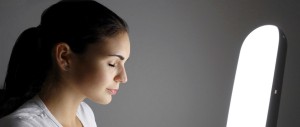
Light therapy is as simple as it sounds: sitting near a bright light often enough and long enough for the brain to think that it’s getting orders from the sun, which is in short supply in winter months.
Also called phototherapy, light therapy is surging in popularity, thanks to a spate of studies that show it to be effective in improving mood, reducing fatigue and improving focus. The practice has also benefited from a decline in prices that have made light therapy lamps affordable for more people.
Nikki Martinez, a Chicago psychologist, said only a few years ago the most inexpensive lights used for phototherapy cost several hundred dollars, but good ones are now available for less than $100, and no prescription is needed.
“I believe they help,” Martinez said. “I believe the research, and I have seen them work for myself and for patients.”
Studies by the Mayo Clinic, the University of Vermont and Columbia University, among others, have shown significant and sustained improvement in the moods and focus of people who try light therapy. The therapy has even helped Alzheimer’s patients sleep and focus better, and it’s being tried in schools to help winter-weary students pay attention.
In Sweden, one high school has installed therapy lights throughout the building. And in Erie, Pennsylvania, a reading teacher saw an improvement in fourth-graders’ attention after just a few days using the light. “The few days that I used it were wonderful,” said teacher Lynda Pryor. “They were more on target than they usually are.”
Unlike tanning beds and booths, which are considered carcinogens, light therapy lamps do not emit ultraviolet light. Instead, they use white or blue light that ranges in intensity from 5,000 to 10,000 lux. That’s 100 times brighter than a room lit normally, but only half as bright as strong sunlight. Another way the lights are different from tanning beds: You have to have your eyes open to get the benefit. (People using tanning beds must protect their eyes.)
“The light needs to get into the retina to be effective,” said Jeffrey Anshel, an optometrist in Encinitas, California. The retina, he explained, sends a message to the part of the brain that controls circadian rhythms, the day-and-night cycle that governs most living organisms, and is disrupted by changes like travel across time zones or shortened days in winter. That message is, in effect, everything’s all right.
For most healthy people, light therapy can be an inexpensive way to lift spirits and raise energy levels without drugs, Martinez, the Chicago psychologist, said. And she finds it easy to work into her day: She uses her light in the morning while she is reading email.
“We’ve had long and hard winters here for the past few years, and I have noticed an increase in depression in my patients. I’m not saying that this eliminates it completely, but it does help,” Martinez said.
“In Chicago, winter is nine months out of the year, and we do anything it takes to get through it.”
Jennifer Graham
Deseret News
